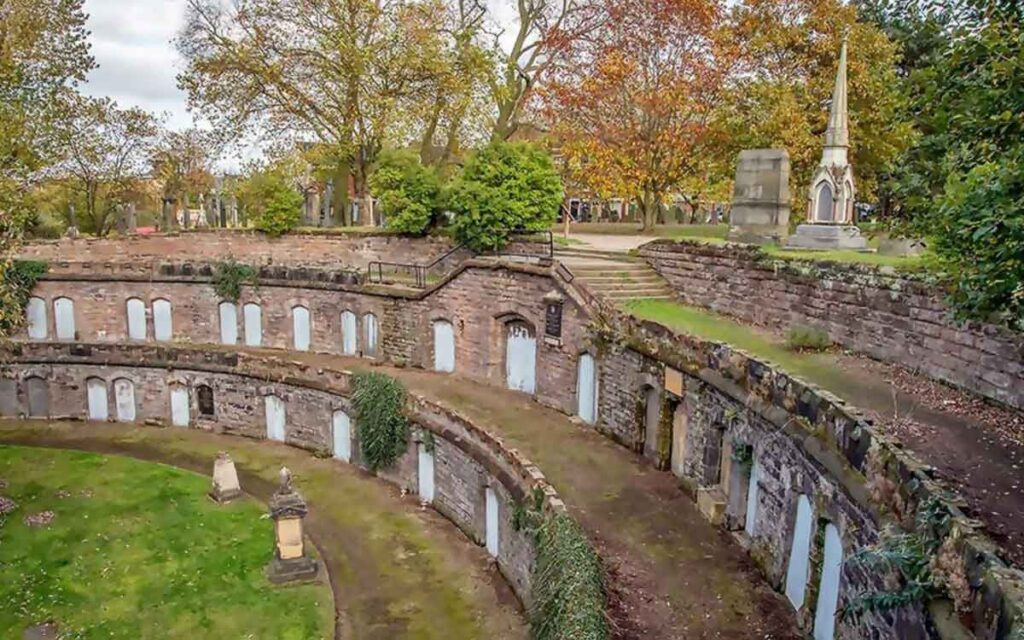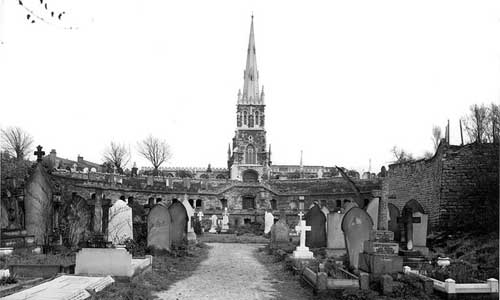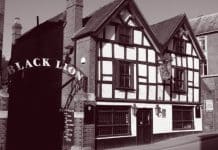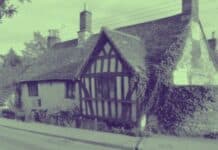Warstone Lane Cemetery is one of two cemeteries that sit within the Jewellery Quarter in Birmingham. It’s home to a few notable burials. And, a few more unusual paranormal happenings. CHRISTINE MILLER tells us all about it…

The History of Warstone Lane Cemetery
Warstone Lane Cemetery was first established in 1848 by a private company, eventually being closed to burials almost 140 years later in 1982.
It was initially designed as a pragmatic solution to the all-too-common problem of graveyard overcrowding, which often plagued countless burial grounds throughout the West Midlands and further up and down the country at the time.
With the city’s corpse congestion somewhat remedied thanks to the addition of Warstone Lane Cemetery, there was unfortunately another concern that needed to be straightened out.
The issue involved the distinct two-tiered catacombs within the graveyard, which soon began to cause quite a ruckus amongst visitors when the dead within began to emit an entirely overbearing sickly smell.
Birmingham Council were quick to act to diminish the pungent aromas, soon leading to the passing of the Birmingham Council Act, whereby coffins were required to be sealed with lead before being placed within the catacombs.
Mercifully, the obscene smells are long gone and the cemetery is a haven for many visitors today. Some of the flat tombs are, on occasion, used as impromptu tables for those wanting an alfresco dining experience in the unique surroundings.
There are a few notable headstones within the cemetery; that of the Hipkin family, for example. William Hipkin died on the SS Titanic when it tragically descended into the frigid waters of the Atlantic on the fateful night of 15th April 1912.
His family tomb lies in Warstone Lane with an inscription dedicated to the 55-year-old widower, which reads: “The Sea Shall Give Up Its Dead”.
Sadly, in Hipkin’s case, this was never to be, as his body was never recovered.

Foul-Smelling Remains
Another grave with an interesting tale attached is that of the highly successful businessman and noted atheist John Baskerville, who died in 1775 – sometime before Warstone Lane Cemetery was even imagined.
So, just why is he buried in the cemetery at all then, you might ask?
The story is a bit of a grisly one.
It is known that in his life, Baskerville left detailed instructions about the handling of his earthly remains; he was to be buried upright in his grave in an airtight coffin that was lead-lined, most likely to preserve his body better.
And, under no circumstances were his earthly remains to be placed anywhere near consecrated ground, never mind in it.
When he passed away, his wishes were respectfully carried out, and he rested in peace for some time in a mausoleum within the grounds of his home.
That is until the builders turned up in 1821 and disturbed his coffin.
There was immediate confusion as to what was to be done with the coffin – Baskerville’s wife had long since died, and the home was no longer in the hands of the family, so it was decided the coffin couldn’t be reinterred into the mausoleum.
Unfortunately, there were no distant relatives of Baskerville who were forthcoming to claim his body.
There also wasn’t a churchyard in the land that wanted to welcome the remains of the outspoken and controversial atheist, so where to place the man became quite a problem.
Eventually, he was moved to the warehouse of one Mr Thomas Gibson. Gibson, being a peculiar type of fellow, would delight in presenting the well-preserved corpse to anyone and everyone brave enough to stomach the sight.
Saying that, however; although Baskerville’s eyes were long gone and his body was emitting a strong smell of “decayed cheese”, according to one curious onlooker, his nails, hair, eyelashes, and eyebrows were still very recognisable. The condition of the skin was also said to have been relatively fresh, considering the amount of time the man had been extinct.
However, the 50-year-old remains did not fare well in this new location, to the point where the body soon began to deteriorate and putrefy quickly.
By this time, Gibson had had enough – his intense morbid curiosity had found its limit – and so Baskerville was moved to the home of another man named John Marston.
Even with the coffin lid firmly sealed however, the effluvium became close to unbearable, and it would soon be time for Baskerville to be moved yet again.
Marston, somewhat amazingly, miraculously even, managed to strike a deal of sorts with nearby Christ Church for his not-so-fragrant friend to be placed within the underground catacombs there.
Although, as we know, it still doesn’t end there.
By 1899, Baskerville was uprooted yet once again (alongside nearly 600 other bodies), to Warstone Lane Cemetery when Christ Church was demolished, and it is here where he has rested ever since.
Just how disgusted Baskerville would feel about spending eternity in consecrated ground, I think we can confidently guess at; could he be responsible for some of the spooky activity that has been reported in and around Warstone Lane Cemetery?
Other Spectral Residents At The Cemetery
If Baskerville does haunt his final resting place, he’s certainly in good company; what haunted location would be complete without a White Lady?
Warstone Lane has its own spectral female garbed in white, and she isn’t only confined to the graveyard itself. She often walks through the cemetery walls and disappears outside its perimeter to unsettle drivers.
One motorist was perplexed when the woman he had almost hit with his car because of how suddenly she appeared just as suddenly vanished into thin air again.
But, not before grinning at him mischievously, that is.
When she’s not terrifying motorists, she spends the afterlife wandering aimlessly throughout the cemetery; she is said to be dressed in old fashioned clothing, possibly from the 1920s or 30s. Witnesses to her visitation have claimed to have smelt the smell of pear drops emanating from her ghostly form.
Another woman, said to be younger in appearance to The White Lady, sits happily atop one of the tombstones and has most often been witnessed at dusk, just as the sun is setting.
Just why she chooses this particular tomb to sit on, is unknown.
Yet another of the ghosts that frequent the cemetery is even said to have spoken to a witness close to the catacombs.
One morning, a young man wearing an army coat approached a stranger. He inquired as to the location of “The Infirmary”, which struck the witness as curious because the hospital he was referring to, Dudley Road Hospital, had not been known as The Infirmary since World War ll.
The witness explained where the hospital was located and bid the man goodbye. But, having an uneasy feeling immediately after his departure, spun around quickly, only to be shocked to see the man had simply and inexplicably disappeared.
The Curious Nature Of Graveyard Hauntings
There’s no denying that Warstone Lane Cemetery is an interesting location, but with the amount of paranormal activity reported there, it begs the question, why would a spirit be compelled to haunt a graveyard?
John Baskerville, being the antithesis of religious, might understandably be somewhat vexed at being plopped in a holy site for all of eternity and so he haunts the cemetery for this very reason – but why do others seem so active in the area?
Conventional wisdom amongst paranormal researchers and scholars states that spirits are keen to spend the afterlife haunting those places they loved when they were alive, comforted by the familiarity of their surroundings and wishing to be close to their loved ones.
Or, more unsettlingly, they are stuck in the very place where they had a violent or sudden passing, leaving them confused and therefore unable to move on.
Of course, it isn’t just Walstone Lane that’s haunted; cemeteries such as Highgate Cemetery in London, Greyfriars Kirkyard in Edinburgh, and the Glasgow Necropolis are all said to be home to some very unusual goings on, however it does seem odd that such places would be privy to visits from the restless dead.
So, why is Warstone Lane Cemetery just so haunted? It is, like the aforementioned graveyards, simply a final destination for so many dead who would have, most likely anyway, had little connection to the graveyard when alive.
Possible Explanations For The Hauntings in Warstone Lane
It seems that no one really knows for sure, but one explanation might be, as many bodies within Warstone Lane were constantly being moved from place to place, this could have unsettled some of the inhabitants.
Others might argue that the land and what it was used for previously gives rise to hauntings.
Before being Warstone Lane, the area was called Dead Man’s Lane, and there is some speculation that a gallows would have been located somewhere close by.
And a location for so many executions surely would make for quite a few restless souls.
Or, could it be the ground’s energy, perhaps? The presence of ley lines often denotes the chances of an area being haunted, and there is a large one relatively close by to Warstone Lane Cemetery known as the British Latitudinal Ley Line, which stretches over 560 miles Northward.
This isn’t to say that smaller ley lines – which usually branch off from larger ones – do not lie in the vicinity of the cemetery, thus affecting the level at which the ghosts operate.
Another possible theory for why graveyards harbour ghosts is that some individuals who die wish to maintain a close connection with their bodily remains and are therefore earthbound.
Whatever the reason ghosts haunt graveyards, Warstone Lane Cemetery is a prime example of a place that shouldn’t necessarily be haunted, but yet, the restless dead are more than keen to make themselves known to the living.
Have you visited Warstone Lane Cemetery in Birmingham and felt, or perhaps even seen something that you can’t quite explain? Let us know in the comments sections below.
With thanks to Robb Ross for his assistance in making this article possible.
Watch our Spooky Isles video with Kate Cherrell talking about her favourite cemeteries, which includes Warstone Lane Cemetery!







